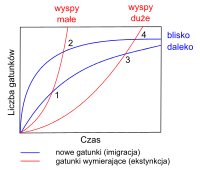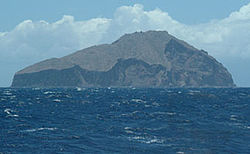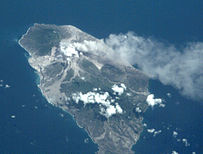Robert MacArthur
| Data i miejsce urodzenia | 7 kwietnia 1930 |
|---|---|
| Data i miejsce śmierci | 1 listopada 1972 |
| Przyczyna śmierci | |
| Zawód, zajęcie | biogeograf, ekolog |
| Narodowość | amerykańska |
| Tytuł naukowy | |
| Alma Mater | Marlboro College w Vermoncie, |
| Uczelnia | |
| Rodzice | John Wood MacArthur, |
| Małżeństwo | Elizabeth Bayles Whittemore |
| Dzieci | Duncan, Alan, Elizabeth, Donald |
| Krewni i powinowaci | brat John Wood MacArthur, Jr. (fizyk) |
Robert Helmer MacArthur (ur. 7 kwietnia 1930 w Toronto, zm. 1 listopada 1972 w Princeton) – amerykański ekolog biogeograf uważany za jednego z twórców ekologii ewolucyjnej, związany z Uniwersytetem Pensylwanii i Uniwersytetem w Princeton, członek National Academy of Sciences od 1969.
Życiorys
Był młodszym synem Johna W. i Olive (Turner) MacArthur[1]. Ojciec był genetykiem, profesore Uniwersytetu Torontońskiego i Marlboro College w Vermoncie, a starszy syn (John W. MacArthur, Jr.) został fizykiem[2][3][4].
Robert MacArthur skończył Marlboro College w 1951, a w 1952 uzyskał na Uniwersytecie Browna tytuł magistra matematyki. W latach 1953–1957 na Uniwersytecie Yale’a realizował pracę doktorską pod opieką naukową G.E. Hutchinsona (zob. nisza ekologiczna Hutchinsona). Po otrzymaniu stopnia Ph.D. odbył podoktorski staż naukowy w zakresie terenowej ornitologii w Uniwersytecie Oksfordzkim (1957–1958). Współpracował z Davidem Lackiem, jedną z osób kształtujących jego zainteresowania ekologiczne, połączone z rozbudzonymi przez starszego brata zainteresowaniami matematyką. W latach 1958–1965 zajmował stanowisko assistant professor na Uniwersytecie Pensylwanii, a od 1965 do śmierci był full professor na Uniwersytecie w Princeton, gdzie kończył wówczas zawodową karierę Henry Fairfield Osborn, profesor biologii[2][3][4].
Tematyka pracy naukowej
Praca doktorska
Praca doktorska R. MacArthura, wykonywana pod opieką G.E. Hutchinsona – twórcy pojęcia n-wymiarowej niszy ekologicznej, dotyczyła nisz pięciu gatunków owadożernych ptaków z rzędu wróblowych (Passeriformes) żerujących w lasach New England (Cape May, Yellow-rumped, Black-throated Green, Blackburnian i Bay-breasted). Rejestrował częstość i czas żerowania ptaków poszczególnych gatunków w różnych strefach poszczególnych jodeł, świerków i sosen, na różnych wysokościach, w różnych odległościach od pnia, na końcach gałązek ze świeżymi igłami i pączkami, wśród martwych igieł oraz na gałązkach bez igieł, pokrytych porostami (16 różnych stref). Zgromadził dane doświadczalne pozwalające wykazać, że liczebność populacji ptaków jest ograniczana przez dostępność pokarmu (pojemność środowiska) oraz że różne gatunki nie zajmują tej samej niszy ekologicznej wbrew zasadzie wypierania (jak wówczas uważano) – mają różne preferencje żywieniowe[5]. Był to wniosek istotny dla ekologii populacyjnej i ewolucyjnej, potwierdzający rolę konkurencji międzygatunkowej w kształtowaniu struktury ekosystemu, co sprawiło, że młody naukowiec został uznany za jednego z twórców ekologii ewolucyjnej[2][3].
Biogeografia wysp

Za kluczową publikację R. MacArthura jest uważana książka pt. The Theory of Island Biogeography (1967), napisana wspólnie z E. O. Wilsonem. Model biogeografii wysp MacArthura-Wilsona (i jego późniejsze modyfikacje) wiąże liczbę gatunków na wyspie z[7][8]:
- wielkością jej powierzchni (związaną z długością linii brzegowej),
- topografią wyspy (związaną ze zróżnicowaniem zasobów i typów siedlisk),
- odległością od obszarów, z których organizmy nowych gatunków mogą dotrzeć na wyspę,
- gatunkowym bogactwem tych obszarów,
- szybkością imigracji i ekstynkcji.
Popularność książki, która znajdowała się przez dziesięciolecia w centrum dyskusji na temat geograficznego rozmieszczenia i rozprzestrzeniania się gatunków, była porównywana[2][3][9] z popularnością The Song of the Dodo: Island Biogeography in an Age of Extinction Davida Quammena[10].
Publikacje
Wykaz publikacji Roberta MacArthura (według strony internetowej Uniwersytetu Teksańskiego w Austin)[3][11]:
- 1955
- – Fluctuations of animal populations, and a measure of community stability. Ecology 36: 533–536,
- 1957
- – On the relative abundance of bird species. Proc. Nat. Acad. Sci. USA 43: 293–295,
- 1958
- – North American birds staying on board ship during Atlantic crossing (wsp. P. Klopfer). Brit. Birds 51: 358,
- – A note on stationary age distributions in single-species populations and stationary species populations in a community. Ecology 39: 146–147,
- – Population ecology of some warblers of northeastern coniferous forests. Ecology 39: 599–619,
- – North American birds staying on board ship during Atlantic crossing (wsp. P. Klopfer). Brit. Birds 51: 358,
- 1959
- – A theoretical ecological model of size distributions among species of animals (wsp. G.E. Hutchinson). Amer. Natur. 93: 117–125,
- – On the theoretical significance of aggressive neglect in interspecific competition (wsp. G.E. Hutchinson). Amer. Natur. 93: 133–134,
- – On the breeding distribution pattern of North American migrant-birds, Auk 76: 318–325,
- – A theoretical ecological model of size distributions among species of animals (wsp. G.E. Hutchinson). Amer. Natur. 93: 117–125,
- 1960
- – On the relative abundance of species. Amer. Natur. 94: 25–36,
- – Niche size and faunal diversity (wsp. P.H. Klopfer). Amer. Natur. 94: 293–300,
- – On Dr. Birch's article on population ecology. Amer. Natur. 94: 313,
- – On the relation between reproductive value and optimal predation. Proc. Nat. Acad. Sci. U.S. 46: 144–145,
- – Review of Cold Spring Harbor Symposium Vol, XXII. Quart. Rev. Biol. 35: 82–83,
- – Communities. In Gray's Encyclopedia of Biological Science,
- – On the relative abundance of species. Amer. Natur. 94: 25–36,
- 1961
- – Population effects of natural selection. Amer. Natur. 95: 195–199,
- – On the causes of tropical species diversity: niche overlap (wsp. P.H. Klopfer). Amer. Natur. 95: 223–226,
- – On bird species diversity (wsp. J.W. MacArthur). Ecology 42: 594–598,
- – Population effects of natural selection. Amer. Natur. 95: 195–199,
- 1962
- – On bird species diversity II. Prediction of bird censuses from habitat measurements (wsp. J.W. MacArthur, J. Preer). Amer. Natur. 96: 167–174,
- – Some generalized theorems of natural selection. Proc. Nat. Acad. Sci. USA 48: 1893–1897,
- – On bird species diversity II. Prediction of bird censuses from habitat measurements (wsp. J.W. MacArthur, J. Preer). Amer. Natur. 96: 167–174,
- 1963
- – Graphical representation of stability conditions of predator-prey interactions (wsp. M. Rosenzweig). Amer. Natur. 97: 209–223,
- – An equilibrium theory of insular zoogeography (wsp. E.O. Wilson). Evolution 17: 373–387,
- – Graphical representation of stability conditions of predator-prey interactions (wsp. M. Rosenzweig). Amer. Natur. 97: 209–223,
- 1964
- – Environmental factors affecting bird species diversity. Amer. Natur. 98: 387–397,
- – Computer simulation and analysis of simple ecological systems (wsp. D. Garfinkel, R. Sack). Ann. N.Y. Acad. Sci. 115: 943–951,
- – A field's capacity to support a butterfly population (wsp. V. G. Dethier). Nature 21: 728–729,
- – Competition habitat selection and character displacement in a patchy environment (wsp. R. Levins). Proc. Nat. Acad. Sci. USA 51: 1207–1210,
- – Ecology. Pp. 230–233 w: A.L. Thompson ed. New Dictionary of Birds. Nelson,
- – Environmental factors affecting bird species diversity. Amer. Natur. 98: 387–397,
- 1965
- – Patterns of species diversity. Biol. Reviews 40: 510–533,
- – Ecological consequences of natural selection. Pp. 388–397 w: T. H. Waterman, H. J. Morowitz, eds., Theoretical and Mathematical Biology. Blaisdell,
- – Patterns of species diversity. Biol. Reviews 40: 510–533,
- 1966
- – On the relation between habitat selection and species diversity (wsp. H. Reche, M. Cody). Amer. Natur. 100: 319–332,
- – The maintenance of genetic polymorphism in a spatially heterogeneous environment: variations on a theme by Howard Levene (wsp. R. Levins). Amer. Natur. 180: 585–589,
- – On optimal use of a patchy environment (wsp. E.R. Pianka). Amer. Natur. 100: 603–609,
- – A reformulation of alternative b of the broken stick model of species abundance (wsp. J. Vandermeer). Ecology 47: 139–140,
- – Note on Mrs. Pielou's comments. Ecology 47: 1074,
- – The Biology of Populations (wsp. J.W. Connell). 200pp. Wiley,
- – On the relation between habitat selection and species diversity (wsp. H. Reche, M. Cody). Amer. Natur. 100: 319–332,
- 1967
- – The limiting similarity, convergence and divergence of coexisting species (wsp. R. Levins). Amer. Natur. 101: 377–385,
- – The Theory of Island Biogeography (wsp. E.O. Wilson). 203pp. Princeton,
- – The limiting similarity, convergence and divergence of coexisting species (wsp. R. Levins). Amer. Natur. 101: 377–385,
- 1968
- – Selection for life tables in periodic environments. Amer. Natur. 102: 381–383,
- – The theory of the niche. Pp. 159–176 w" R.C. Lewontin, ed., Population Biology and Evolution. Syracuse,
- – Selection for life tables in periodic environments. Amer. Natur. 102: 381–383,
- 1969
- – Patterns of communities in the tropics. Biol. J. Linn. Soc. 1: 19–30,
- – The ecologist's telescope. Ecology 50: 353,
- – Foliage profile by vertical measurements (wsp. H.S. Horn). Ecology 50: 802–804,
- – An hypothesis to explain the incidence of monophagy (wsp. R. Levins). Ecology 50: 910–911,
- – Species packing and what interspecific competition minimizes. Proc. Nat. Acad. Sci. USA 64: 1369–1371,
- – Patterns of communities in the tropics. Biol. J. Linn. Soc. 1: 19–30,
- 1970
- – Graphical analysis of ecological systems. Pp. 61–72 w: Some Mathematical Questions in Biology. Am. Math. Soc.,
- – Species packing and competitive equilibrium for many species. Theoret. Population Biol. 1: 1–11,
- – Graphical analysis of ecological systems. Pp. 61–72 w: Some Mathematical Questions in Biology. Am. Math. Soc.,
- 1971
- – Patterns of terrestrial bird communities. Pp. 189–221 w: D. S. Farner i J. R. King, eds., Avian Biology vol. I, Academic,
- 1972
- – Density compensation in island faunas (wsp. J.M. Diamond, J. R. Karr). Ecology 53: 330–342,
- – Competition among fugitive species in a harlequin environment (wsp. H.S. Horn). Ecology 53: 749–752,
- – Efficiency and preference at a bird feeder (wsp. D. MacArthur). J. Ariz. Acad. Sci. 7: 3–5,
- – Niche overlap as a function of environmental variability (wsp. R.M. May). Proc. Nat. Acad. Sci. USA 69: 1109–1113,
- – Strong, or weak, interactions? Trans. Conn. Acad. Arts and Sci. 44: 177–188,
- – Coexistence of species. Pp. 253–259 in J. Benke, ed., Challenging Biological Problems. Oxford,
- – Geographical Ecology. 269pp. Harper and Row,
- – Density compensation in island faunas (wsp. J.M. Diamond, J. R. Karr). Ecology 53: 330–342,
- 1973
- – The effect of island area on population densities (wsp. J. MacArthur, D. MacArthur, A. MacArthur). Ecology 54: 657–658,
- 1974
- – On the use of mist nets for population studies of birds (wsp. A.T. MacArthur). Proc. Nat. Acad. Sci. USA. 71: 3230–3233.
Wyróżnienia
W roku 1959 otrzymał Goerge Mercer Award od Ecological Society of America za pracę nt. Population ecology of some warblers of northeastern coniferous forests (Ecology 39:599–619)[12]. W roku 1969 został członkiem National Academy of Sciences[3].
Od roku 1983 ESA przyznaje Robert H. MacArthur Award za merytoryczny wkład w ekologię, w oczekiwaniu dalszych osiągnięć. Nagroda jest przyznawana co dwa lata osobom w środku kariery naukowej[12]
Życie prywatne
Ożenił się w roku 1952 z Elizabeth Bayles Whittemore, z którą miał czworo dzieci (Duncan, Alan, Elizabeth i Donald). Zmarł 1 listopada 1972 roku w Princeton na raka nerki[1][2].
Przypisy
- ↑ a b c MacArthur, Robert Helmer (ang.). W: what-when-how In Depth Tutorials and Information, Lyme disease [on-line]. [dostęp 2013-07-04].
- ↑ a b c d e MacArthur, Robert Helmer (ang.). W: Complete Dictionary of Scientific Biography [on-line]. 2008. [dostęp 2013-07-04].
- ↑ a b c d e f Robert H. MacArthur (ang.). W: Strona internetowa Uniwersytetu Teksańskiego w Austin [on-line]. [dostęp 2018-02-10]. [zarchiwizowane z tego adresu (2016-07-19)].
- ↑ a b Robert Helmer MacArthur (1930–1972) (ang.). W: Strona internetowa National Center for Ecological Analysis and Synthesis (NCEAS) [on-line]. [dostęp 2013-07-04]. [zarchiwizowane z tego adresu (2013-05-16)].
- ↑ a b Bird Communities and Competition > MacArthur's Warblers (ang.). W: www.stanford.edu [on-line]. [dostęp 2013-07-04].
- ↑ Charles J. Krebs (tłum. Anna Kozakiewicz, Michał Kozakiewicz, Jakub Szacki): Ekologia. Eksperymentalna analiza rozmieszczenia i liczebności. Wyd. 4. Warszawa: Wydawnictwo Naukowe PWN, 1997, s. 227.
- ↑ Ryszard Laskowski (Uniwersytet Jagielloński): Biogeografia wysp. MacArthur i inni. W: Wykład (pdf) [on-line]. eko.uj.edu.pl. [dostęp 2018-02-11]. [zarchiwizowane z tego adresu (2014-08-24)].
- ↑ January Weiner (Uniwersytet Jagielloński): Wykład 13: Przestrzenna zmienność zmienność historii życiowych * Wyspy > Model MacArthura-Wilsona. W: Materiały dydaktyczne; 'Różnorodność biosfery', WBNZ 845 (Biogeografia ekologiczna i ewolucyjna) [on-line]. eko.uj.edu.pl. [dostęp 2017-03-24].
- ↑ Robert H. MacArthur, Edward O. Wilson: The Theory of Island Biogeography (ang.). Princeton University Press, 1967. [dostęp 2013-07-04].;recenzja książki
- ↑ David Quammen (ang.). Lannan Foundation. [dostęp 2013-07-08].
- ↑ Edward O. Wilson, Evelyn G. Hutchinson: Robert Helmer MacArthur (April 7, 1930 – November 1, 1972) (ang.). W: Biographical Memoirs V. 58 [on-line]. zo.utexas.edu, 1989. s. 318–327. [dostęp 2013-07-04].
- ↑ a b „Goerge Mercer Award” i „Robert H. MacArthur Award” (ang.). W: Strona internetowa Ecological Society of America [on-line]. [dostęp 2013-07-07].
Media użyte na tej stronie
Total number of species of amphibians and reptilians on seven different islands in the West Indies. Based on Figure 2 on page 8 of "The theory of island biogeography" by MacArthur and Wilson, itself based on research by Darlington circa 1957. (Hence, the numbers are likely to differ from actual numbers today.)
Autor: Joanna Kośmider, Licencja: CC BY-SA 3.0
Nisze ekologiczne ptaków z rodziny lasówek (Dendroica, Setophaga) – Dendroica tigrinai Dendroica castanea (według Ch. J. Krebsa)
Autor: Joanna Kośmider, Licencja: CC BY-SA 3.0
Biogeografia wysp. Model MacArthura-Wilsona
Wetlands in Cape May, New Jersey, USA. View of Fishing Creek Marsh with Miami Beach, New Jersey on the left. A managed by Cape May County Park system.












